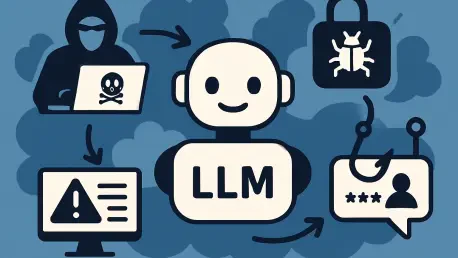The transformative potential of Large Language Model (LLM) applications is undeniable, reshaping everything from automated customer support to sophisticated data analysis platforms, while also attracting the attention of malicious actors seeking to exploit their weaknesses. As these tools become integral to modern industries, the NVIDIA AI Red Team (AIRT) has dedicated significant effort to uncovering critical vulnerabilities in LLM-powered systems, revealing risks that could jeopardize entire infrastructures if not addressed promptly. Their findings act as a crucial alert for developers and security experts, highlighting the urgent need to prioritize robust defenses. By delving into AIRT’s comprehensive assessments, this article aims to unpack the most pressing threats facing LLM applications. From the execution of harmful code to flaws in data access controls, the dangers are both real and immediate. Fortunately, actionable strategies exist to mitigate these risks, offering a path toward safer AI deployments. The dynamic and unpredictable nature of LLMs underscores the importance of embedding security into every layer of design, ensuring innovation doesn’t come at the cost of vulnerability.
Unpacking Critical Vulnerabilities in LLM Systems
Dangers of Remote Code Execution (RCE)
The execution of LLM-generated code stands out as a particularly severe threat, according to AIRT’s extensive evaluations. When applications rely on functions like exec or eval to process dynamic scripts—often for tasks like generating visualizations or running quick analyses—they inadvertently create a gateway for attackers. Through techniques such as prompt injection, malicious code can be crafted and executed, potentially leading to remote code execution (RCE). This type of breach could grant unauthorized control over the system, compromising sensitive operations. AIRT emphasizes that even subtle oversights in handling these outputs can have devastating consequences, as attackers often use obfuscation to bypass existing safeguards. The gravity of this issue lies in its ability to affect the core integrity of an application, making it a top priority for mitigation.
Beyond the mechanics of code execution, the broader implications of RCE reveal a systemic challenge in LLM application development. Many developers, driven by the need for rapid prototyping or flexible functionality, opt for shortcuts that prioritize ease over safety. AIRT’s research illustrates how prompt injections can exploit these conveniences, turning a seemingly harmless feature into a critical vulnerability. The unpredictability of LLM outputs exacerbates this risk, as even well-intentioned inputs can be manipulated into harmful actions. Addressing this requires not just technical fixes but a fundamental shift in mindset—moving away from reactive patches to proactive design principles that anticipate and neutralize threats before they manifest. This approach ensures that innovation in AI doesn’t become a liability.
Flaws in Retrieval-Augmented Generation (RAG) Access Controls
Retrieval-Augmented Generation (RAG) architectures, which enhance LLM responses by integrating external data, introduce significant security challenges, as highlighted by AIRT. A common issue lies in misconfigured permissions within data sources, such as internal databases or cloud-based repositories. These flaws often allow unauthorized access to sensitive information, exposing organizations to data breaches. Additionally, overly permissive write access can enable attackers to inject malicious content into RAG data stores, a tactic known as data poisoning. Such manipulations can skew LLM outputs or facilitate further exploits. AIRT’s findings point to a recurring lack of alignment between source system permissions and RAG databases, amplifying the risk of exposure across interconnected systems.
Another layer of concern with RAG systems is the delayed propagation of permission updates, which can leave sensitive data vulnerable for extended periods. AIRT notes that even when permissions are adjusted at the source, lags in synchronization with RAG pipelines can create windows of opportunity for attackers. Furthermore, the complexity of managing access across diverse data sources—ranging from corporate intranets to public-facing repositories—often leads to oversight. This is compounded by the absence of robust mechanisms to segregate data based on sensitivity or user roles. The cumulative effect is a heightened risk of cross-contamination, where compromised data from one source impacts the integrity of the entire system. Tackling these issues demands meticulous attention to access control design and real-time monitoring of permission states.
Risks of Data Exfiltration Through Active Content
Active content rendering in LLM outputs, such as displaying hyperlinks or images, poses a subtle yet dangerous threat, as identified by AIRT. Attackers can embed malicious elements within these outputs, which, when rendered by a user’s browser, transmit sensitive information like conversation histories to external servers. This form of data exfiltration exploits the trust users place in seemingly benign content, making it a particularly insidious vulnerability. Despite being a known issue for some time, many applications still fail to implement adequate controls, leaving them exposed to such attacks. AIRT stresses that the persistence of this flaw underscores a broader gap in prioritizing user interface security.
The mechanics of active content exploitation reveal how deeply intertwined user experience and security have become in LLM applications. Malicious links or images often appear harmless, blending seamlessly into legitimate responses, which makes detection challenging for both users and automated systems. AIRT’s analysis shows that attackers frequently leverage this vulnerability to extract data over prolonged interactions, gradually building comprehensive profiles of sensitive information. The impact extends beyond individual users, potentially compromising organizational data if chat logs or internal documents are leaked. Mitigating this threat requires a delicate balance—preserving the functionality and interactivity of LLM outputs while ensuring that hidden dangers are neutralized before they reach the end user.
Implementing Effective Security Measures
Safeguarding Against RCE with Secure Practices
To counter the threat of remote code execution, AIRT advocates for a complete reevaluation of how LLM-generated code is handled within applications. Rather than relying on risky functions like exec or eval, developers should parse outputs to discern intent and map them to predefined, secure functions. This approach minimizes the chance of executing untrusted code directly, significantly reducing the attack surface. In scenarios where dynamic execution cannot be avoided, AIRT recommends deploying isolated environments, such as WebAssembly-based sandboxes, to contain any potential threats. While implementing these measures may slow down development cycles initially, they are indispensable for preventing breaches that could undermine an entire system’s integrity.
Another critical aspect of securing against RCE lies in fostering a culture of security awareness among development teams. AIRT’s findings suggest that many vulnerabilities stem from a lack of understanding about the risks associated with dynamic code execution. Educating developers on the dangers of prompt injection and the importance of sandboxing can bridge this gap, ensuring that security is not an afterthought but a core component of the design process. Additionally, regular audits of code execution pathways can help identify and eliminate weak points before they are exploited. By combining technical safeguards with organizational best practices, applications can achieve a higher level of resilience against RCE threats, protecting both functionality and trust in LLM systems.
Strengthening RAG Data Security
Securing RAG systems demands a comprehensive strategy that addresses both read and write access vulnerabilities, as outlined by AIRT. Implementing per-user permission checks is essential to ensure that only authorized individuals can access sensitive data, with alignment maintained between source systems and RAG databases. Delays in permission updates must be minimized through automated synchronization processes to close exposure windows. Furthermore, restricting write access to trusted entities prevents data poisoning, where attackers insert harmful content into data stores. These steps collectively reduce the likelihood of unauthorized access or manipulation, safeguarding the integrity of LLM responses.
Beyond basic access controls, AIRT highlights the value of data segregation as a defense mechanism for RAG architectures. By categorizing data sources based on sensitivity or origin—such as separating internal communications from external feeds—applications can limit the spread of compromised content. Guardrails on retrieved content and augmented prompts also play a vital role, ensuring that only relevant and safe information is incorporated into outputs. This multi-layered approach not only addresses technical vulnerabilities but also accounts for the procedural and organizational factors that often contribute to security lapses. Through diligent design and continuous monitoring, RAG systems can become far less susceptible to exploitation, preserving their utility in enhancing LLM capabilities.
Blocking Data Exfiltration Pathways
Preventing data exfiltration through active content rendering requires stringent controls over how LLM outputs are displayed, according to AIRT’s guidance. Enforcing content security policies that restrict image loading to trusted domains is a fundamental step, as it blocks malicious elements from communicating with external servers. Displaying full URLs for hyperlinks, rather than clickable links, adds transparency and allows users to assess legitimacy before interaction. In higher-risk environments, rendering links inactive—requiring manual copy-paste actions—further reduces the chance of accidental data leaks. These measures prioritize safety over convenience, a necessary trade-off in protecting sensitive information.
Sanitization of LLM outputs forms another critical line of defense against exfiltration risks, as AIRT notes. By systematically stripping out potentially harmful content, such as embedded scripts or unverified images, applications can neutralize threats before they reach the user interface. In scenarios where active content cannot be entirely avoided, implementing runtime checks to validate content against a whitelist of acceptable elements offers an additional safeguard. While these practices may slightly impact the seamlessness of user interactions, they are indispensable for environments handling confidential data. Balancing usability with security remains a challenge, but AIRT’s recommendations provide a practical framework for minimizing exposure while maintaining the core functionality of LLM applications.
Building a Resilient Future for AI Security
Reflecting on the insights provided by AIRT, it becomes evident that the vulnerabilities in LLM applications—ranging from remote code execution to data exfiltration—are deeply rooted in the dynamic and unpredictable nature of AI outputs. Their meticulous assessments underscore the critical need for isolation, whether through sandboxing code or sanitizing content, as a foundational principle for mitigating risks. The emphasis on proactive permission management in RAG systems also highlights how procedural diligence is just as vital as technical innovation in preventing breaches. Moving forward, developers are encouraged to integrate these lessons into the earliest stages of design, ensuring that security evolves alongside AI capabilities. Exploring advanced training in adversarial machine learning could further equip teams to anticipate emerging threats. By adopting a mindset of continuous improvement and leveraging AIRT’s actionable strategies, the industry takes significant steps toward fortifying LLM applications against sophisticated attacks, paving the way for safer AI deployments.









